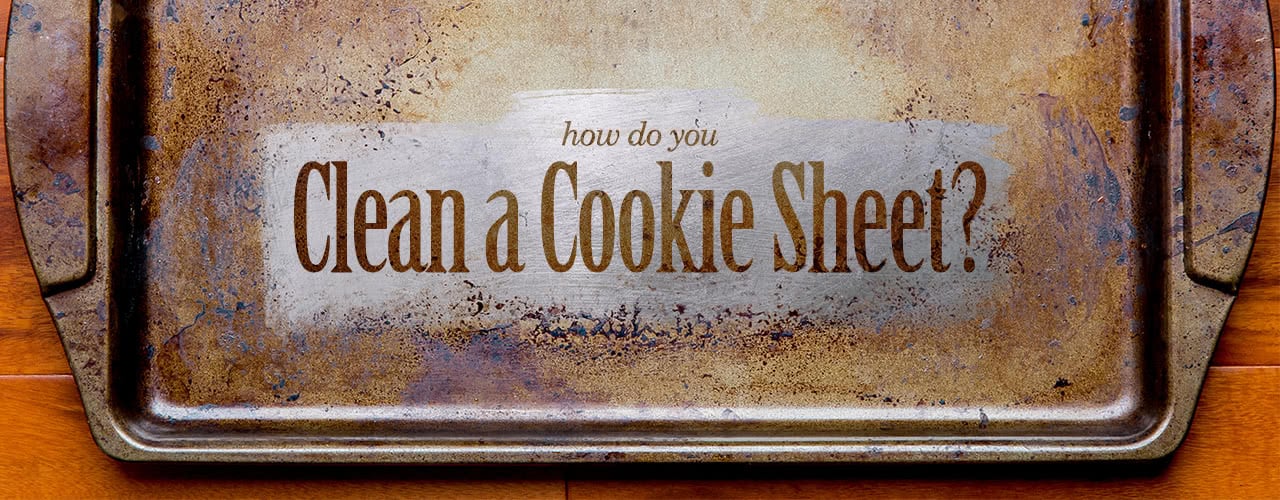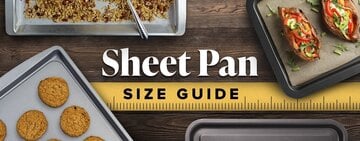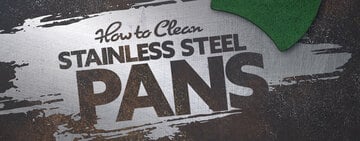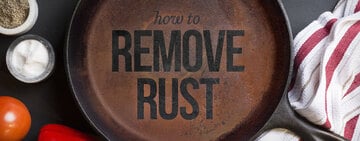How to Clean Baking Sheets
Baking sheets are so versatile you can use them to bake cookies, roast vegetables, or melt cheese over your favorite appetizers. But have you ever noticed how quickly a brand new sheet pan starts to turn brown? Oil residue and burnt food can leave marks that seem impossible to remove. We’ll share our favorite tricks for how to clean baking sheets and make them look brand new again.
Shop All Cookie SheetsBaking Sheet Materials
Before you learn how to clean baking sheets, make sure you know the material of your pan. Baking sheets, baking pans, and cookie sheets can all be cleaned with these methods, but using the wrong technique can ruin the finish on your aluminum or non-stick pans.
Use our cleaning chart for a quick reference of what method to use when cleaning your baking sheets.
| Method: | Aluminized Steel | Aluminum | Non-Stick |
| Baking Soda and Hydrogen Peroxide | Yes | No | No |
| Baking Soda and Vinegar | Yes | Yes | Yes |
| Ammonia | Yes | No | No |
| Aluminum Foil | Yes | No | No |
| Washing Soda and Cream of Tartar | Yes | Yes | Yes |
| Water and Baking Soda | Yes | Yes | Yes |
How to Clean Sheet Pans
Now that you know which methods work with each pan type, you're ready to get started. Check out six easy ways to keep your baking sheets looking brand new:
1. How to Clean Cookie Sheets with Baking Soda and Peroxide
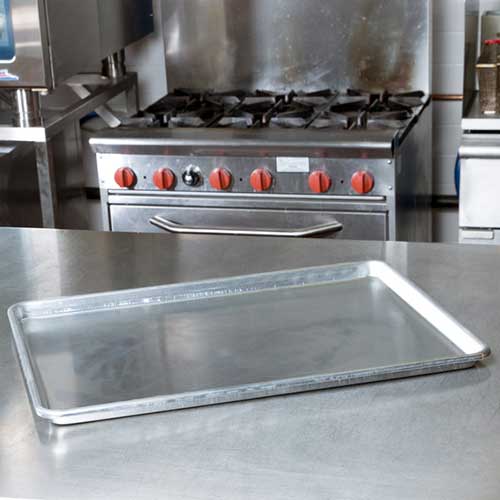
For this method, the most important factor is time. The mixture is simply baking soda and hydrogen peroxide, but you must give it enough time to attack your pan’s food particles and grime. This method should only be used on your aluminized steel pans.
- Mix baking soda and hydrogen peroxide into a paste.
- Spread mixture across the top of the pan.
- Let sit for 2-3 hours.
- Wipe mixture away with a paper towel and water.
- If necessary, scrub any remaining sections.
- Clean with regular soap and water to rid sheet of any remaining residue.
2. How to Clean Cookie Sheets with Baking Soda and Vinegar
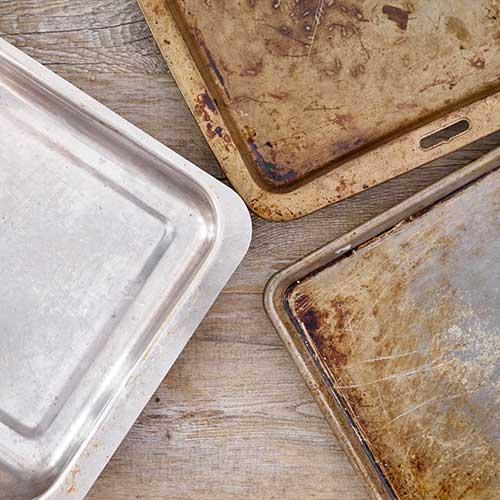
You can clean baking sheets with the effective combination of baking soda and vinegar, two products that can be found in most kitchens. This method should only be used on your aluminum or aluminized steel baking pans.
- Use 1 part baking soda and 1 part vinegar (we recommend 1/4 cup to start).
- Pour the baking soda on the tray and spread evenly across.
- Add vinegar to the tray and watch for the ingredients to begin to react.
- Submerge the tray into a sink filled with hot water.
- Soak the sheet for 30-60 minutes.
- Remove from the water and wipe away dirt and grime with a non-abrasive sponge or microfiber cloth.
- Clean sheet with regular soap and water.
3. How to Clean Cookie Sheets with Ammonia
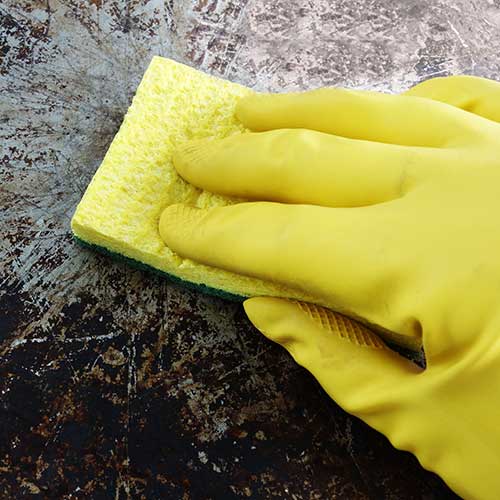
While ammonia can be very effective at removing tough stains and food particles from baking sheets, it's important to note that this method takes the most time to complete and involves harsh chemicals. For your safety, be sure to wear protective gloves, eyewear, and a mask when working with ammonia. Do not use this method for non-stick baking sheets or aluminum pans.
- Place your cookie sheets inside a durable plastic bag, such as a garbage bag.
- Add 1/2 cup of ammonia to the bag.
- Seal the bag shut and let it sit out in the sun for a day to allow enough time for the ammonia to soften and react with grease and food particles.
- Without breathing in the ammonia, open the bag and remove the pans.
- Scrub pans with steel wool.
- Wash the sheets thoroughly.
4. How to Clean Cookie Sheets with Aluminum Foil
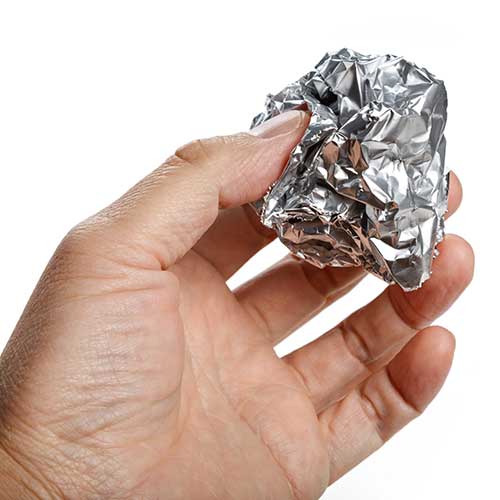
Did you know that rolled-up balls of aluminum foil can be used to clean cookie sheets? It's a quick and easy way to reuse clean pieces of foil. Don't use this method on your aluminum or non-stick baking sheets because it will cause scratches.
- Soak sheet pans in water for an extended period.
- Remove and dry.
- Bunch aluminum foil into a ball and scrub burned spots and stuck-on food.
- Wash and rinse with soap and water.
5. How to Clean Cookie Sheets with Washing Soda and Cream of Tartar
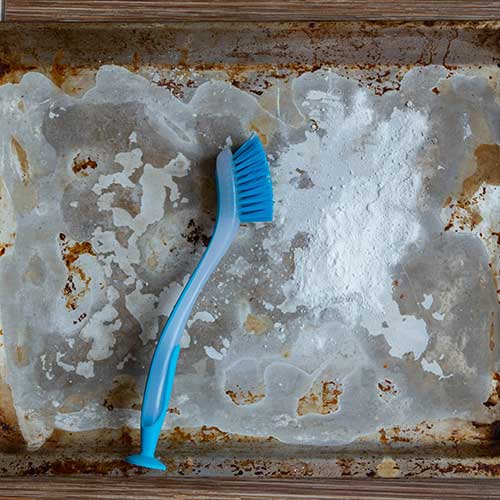
You may not be familiar with washing soda, but it's a helpful cleaning product that is similar to baking soda. Just make sure to wear gloves while handling washing soda because it can cause skin irritation. Cream of tartar is a common baking ingredient that's probably on your shelf right now. This cleaning method is gentle enough to use on your aluminum, aluminized steel, and non-stick pans.
- Sprinkle washing soda and cream of tartar onto the cookie sheet.
- Pour a small amount of hot water on top of the sheet.
- Mix ingredients into a paste.
- Spread paste evenly across the pan.
- Let sit for 15 minutes.
- Scrub stains with a non-abrasive scrubbing pad.
- Wash paste and dirt off the pan with water and soap.
6. How to Clean Cookie Sheets with Baking Soda and Water
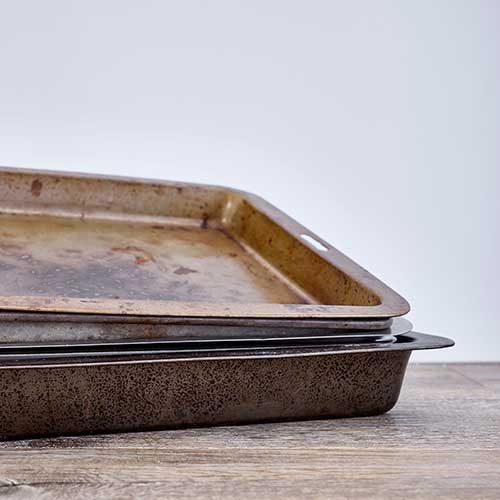
If you have a box of baking soda on hand, you can clean your baking sheets. Baking soda is gentle on pans and won't scratch or discolor the finish. Use this method on aluminum, aluminized steel, and non-stick baking sheets.
- Create a paste with warm water and baking soda.
- Cover the cookie sheet with the paste.
- Let sit for 30 minutes.
- Gently rub stains with a nylon scrubber until the spots are gone.
- Wash thoroughly and dry immediately.
How to Remove Baked On Grease from Pans
Baked-on grease tends to be hard to remove. It's tough, sticky, and doesn't want to budge with normal cleaning. But don't give up on cleaning your cookie sheets just yet. Try our tricks for removing baked on grease from your pans:
How to Clean Aluminized Steel Cookie Sheets
- Best Way to Remove Baked On Grease From Aluminized Steel: Place your cookie sheet on a range top burner with water and a few drops of dish detergent inside. Turn the burner to high heat and bring the water to a gentle boil for about five minutes. Turn off the burner, let the liquid cool completely, then scrub the pan with a stainless steel scrubbing pad to remove the baked-on grease.
- Best Cleaning Tool for Aluminized Steel Pans: Aluminized steel is a tough material that can withstand rough scouring and scrubbing. For any of the methods you use, we recommend using a scouring pad, the rough side of a sponge, or steel wool. It’s important to consider that while it is effective at eliminating stains, steel wool may leave small scratch marks on your pans.
How to Clean Aluminum Cookie Sheets
- How to Clean Baked on Grease from Aluminum Pans: Sprinkle cream of tartar all over the top of your baking sheet. Place the baking sheet on a rangetop burner, add water, and bring to a boil over the stovetop for 5 minutes. This should lift the grease off of the pan. Simply rinse away any remaining residue and dry.
- Best Cleaning Tool for Aluminum Pans: Aluminum baking sheets can be cleaned using similar methods as aluminized steel or stainless steel pans. However, you may need to use a gentler scrubber. To be sure, test the scrubber on a small section on the back of your sheet.
How to Clean Non-Stick Cookie Sheets
- How to Clean Baked On Grease from Non Stick Pans: Sprinkle the top of the cookie sheet with baking soda. Pour vinegar over the baking soda so that the powder begins to fizz. Let the sheet stand for 30 minutes. Gently scrub any remaining grease. Rinse thoroughly and dry.
- Best Cleaning Tool for Non-Stick Pans: To preserve the integrity of the non-stick finish on your cookie sheet, do not use rough or steel scrubbers. Instead, opt for non-abrasive nylon scrubbers. Additionally, it’s recommended you first try covering the cookie sheet with wet paper towels and let the sheet soak for an hour. For minor build-up, this may be effective.
Shop All Scrubbers and Sponges
How to Clean Rust from Cookie Sheets
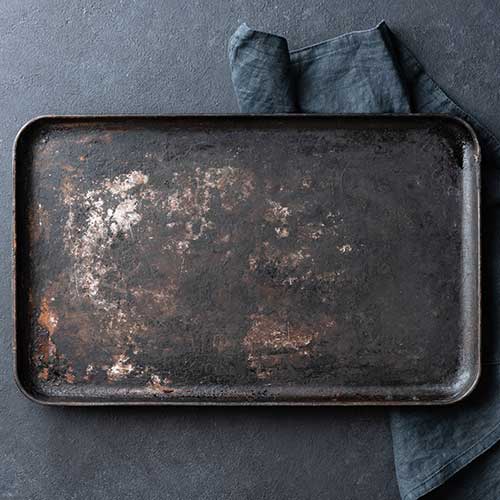
Do you have a collection of old baking sheets that seem to be damaged beyond repair? You may be able to save them! Instead of replacing old baking pans, try these methods to remove rust and make your sheets usable again.
Using a Potato and Baking Soda or Dish Soap
It seems strange, but a cut potato can actually be used to remove rust from your old cookie sheets. Follow these steps to repair your pan:
- Cut the potato in half.
- Dip the cut end in either dish soap or baking soda. To figure out which would be best to use, you may wish to experiment with both.
- Firmly rub the potato over the rusted area. The potato's natural oxalic acid will help break rust down.
- If the potato starts to get slick, slice off the end and dip it in the dish soap or baking soda again.
- Repeat steps until rust is removed.
- Rinse off the pan and dry immediately.
Remove Rust with Baking Soda
Before tossing your rusted sheet pans, try this simple method for repairing the damage:
- Rinse the sheet thoroughly, then shake it dry so it remains slightly damp.
- Lightly dust the pan with baking soda so the powder sticks to the remaining water.
- Make sure all rusty spots are covered with baking soda.
- Let sit for about 30 minutes.
- With the baking soda still on, gently scrub the pan.
- Rinse everything off and towel dry immediately.
Tips for Cleaning Your Cookie Sheets
To prevent the build-up of food residue, grease, or rust, consider these tips for cleaning and maintaining your cookie sheets.
- Avoid large messes to begin with by lining your pan with aluminum foil or parchment paper.
- Coat your pan with a light layer of oil to prevent rusting.
- Dry cookie sheets immediately after washing to avoid a build-up of bacteria and rusting.
- When possible, hand-wash your cookie sheets soon after use.
Cookie sheets are a great, versatile tool to use in your commercial kitchen. Use these methods to ensure longevity and reduce replacement costs. Choose the right method above based on what supplies you already have in your kitchen, any time constraints you may have, and what type of sheet you're using.
